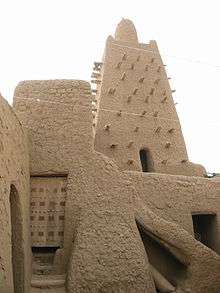Djinguereber Mosque



| Wikimedia Commons has media related to Djinguereber Mosque. |
The Djinguereber Mosque (Masjid) in Timbuktu, Mali is a famous learning center of Mali built in 1327, and cited as Djingareyber or Djingarey Ber in various languages. Its design is accredited to Abu Es Haq es Saheli who was paid 200 kg (40,000 mithqals) of gold by Musa I of Mali, emperor of the Mali Empire. According to Ibn Khaldun, one of the best known sources for 14th century Mali, says al-Sahili was given 12,000 mithkals of gold dust for his designing and building of the djinguereber in Timbuktu. But more reasoned analysis suggests that his role, if any, was quite limited. The architectural crafts in Granada had reached their zenith by the fourteenth century, and its extremely unlikely that a cultured and wealthy poet would have had anything more than a dilettante's knowledge of the intricacies of contemporary architectural practice. [1]
Except for a small part of the northern facade, which was reinforced in the 1960s in alhore (limestone blocks, also widely used in the rest of the town), and the minaret, also built in limestone and rendered with mud,[2] the Djingareyber Mosque is made entirely of earth plus organic materials such as fibre, straw and wood. It has three inner courts, two minarets and twenty-five rows of pillars aligned in an east-west direction and prayer space for 2,000 people.
Djinguereber is one of four madrassas composing the University of Timbuktu. It was inscribed on the list of UNESCO World Heritage Sites in 1988,[3] and in 1990 was considered to be in danger due to sand encroachment.[4] A four-year project towards the restoration and rehabilitation of the Mosque began in June 2006, and is being conducted and financed by the Aga Khan Trust for Culture.[5]
On 26 February 2010, during Mawlid (festival to mark the birth anniversary of Prophet Muhammad), a stampede at the mosque killed around 26 people and injured at least 55 others- mostly women and children.[6]
2012 terror attacks
On 1 July 2012, Islamic extremists of the Ansar Dine (Defenders of Faith) began destroying Timbuktu's cultural treasures shortly after UNESCO placed them on a list of endangered World Heritage sites.[7] Declaring the ancient Muslim shrines "haram", or forbidden in Islam, Ansar Dine set about destroying seven of Timbuktu's sixteen mausolea of ancient Muslim saints,[7] including two tombs at the Djingareyber mosque.[7] Using "hoes, pick-axes and chisels, they hammered away at the two earthen tombs until they were completely destroyed".[7] Damage to the mosque itself was, however, minimal.[8]
References
- ↑ The Meanings of Timbuktu, Bloom, Pg. 52.
- ↑ Djingareyber Mosque Restoration
- ↑ Report of the World Heritage Committee, Twelfth Session, Brasilia, Brazil, 5–9 December 1988: UNESCO Convention Concerning the Protection of World Cultural and Natural Heritage, 1988-12-23, pp. 17–18, SC-88/CONF.001/13, retrieved 2007-04-09
- ↑ Report of the World Heritage Committee, Fourteenth Session, Banff, Alberta, Canada, 7–12 December 1990: UNESCO Convention Concerning the Protection of World Cultural and Natural Heritage, 1990-12-12, pp. 17–18, CLT-90/CONF.004/13, retrieved 2007-04-09
- ↑ "La Cité des 333 saints abrite de nombreux chantiers de modernisation" (in French). Afribone Mali SA. 2007-04-05. Retrieved 2007-04-09.
- ↑ Deadly crush at Timbuktu mosque, BBC News, 26 Feb 2010, retrieved 14 Jun 2010; Pilgrims killed in stampede at Djingareyber Mosque in Timbuktu, UNESCO World Heritage News Archive, 26 Feb 2010, retrieved 14 Jun 2010; 26 dead in Timbuktu mosque stampede, Reuters, 26 Feb 2010, retrieved 14 Jun 2010; Wikinews
- 1 2 3 4 Mali Islamists destroy tombs at ancient Timbuktu mosque | Radio Netherlands Worldwide
- ↑ "Timbuktu's Djinguereber mosque: a history of cities in 50 buildings, day 5". The Guardian. Retrieved 11 September 2015.
- Translated from Ibn Khaldun, loc. cit., p. 348.
External links
Coordinates: 16°46′17″N 3°0′36″W / 16.77139°N 3.01000°W